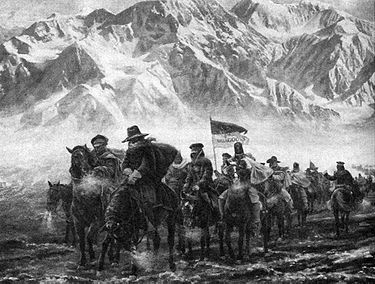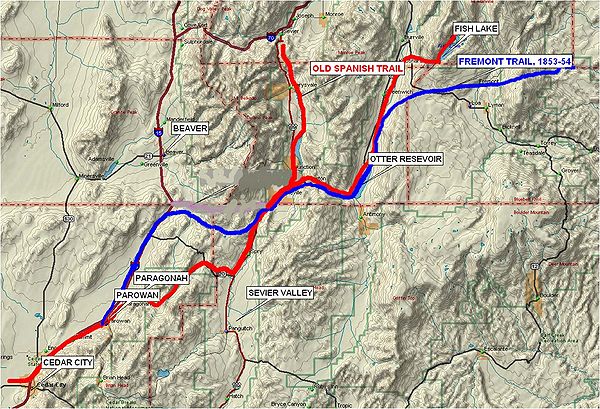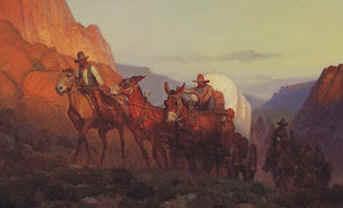Difference between revisions of "A Basic Account"
| Line 5: | Line 5: | ||
== August 16 - September 11, 1857 == | == August 16 - September 11, 1857 == | ||
| − | [[Image:Us 2nd dragoons in utah war 2.jpg|right| | + | [[Image:Us 2nd dragoons in utah war 2.jpg|right|375px|Us 2nd dragoons in utah war 2.jpg]](1) Many Iron County militiamen admitted that in the late summer of 1857, the approaching federal army commanded byColonel Albert Sidney Johnston created a profound sense of crisis. |
| − | [[Image:John m. higbee 1b.jpg|thumb|left|60px]] | + | [[Image:John m. higbee 1b.jpg|thumb|left|60px|John m. higbee 1b.jpg]] |
| − | Major John M. Higbee of the Iron Military District's 3rd Battalion recalled the intense state of alarm or "excitement" among the populace: "[T]he further from [Salt Lake City,] the greater the excitement," Higbee conceded, while the excitement in Cedar City was at "fever heat." | + | Major John M. Higbee of the Iron Military District's 3rd Battalion recalled the intense state of alarm or "excitement" among the populace: "[T]he further from [Salt Lake City,] the greater the excitement," Higbee conceded, while the excitement in Cedar City was at "fever heat." |
| − | [[Image:Albert sidney johnston sketch 4.jpg|thumb|left|80px]](2) The militia leaders of the Iron Military District feared a "southern invasion" of United States dragoons detached from Col. Johnston's army or from Texas or New Mexico approaching over the Old Spanish or Fremont trails. In a contemporary account of conditions in southern Utah, Mormon leader George A. Smith observed that "some rumor or spirit of surprise had reached them." They were "under the impression that their country was about to be invaded by an army from the US" and they were prepared to "touch fire to their homes, hide themselves in the mountains, and defend their country to the last extremity." | + | [[Image:Albert sidney johnston sketch 4.jpg|thumb|left|80px|Albert Sidney Johnston]](2) The militia leaders of the Iron Military District feared a "southern invasion" of United States dragoons detached from Col. Johnston's army or from Texas or New Mexico approaching over the Old Spanish or Fremont trails. In a contemporary account of conditions in southern Utah, Mormon leader George A. Smith observed that "some rumor or spirit of surprise had reached them." They were "under the impression that their country was about to be invaded by an army from the US" and they were prepared to "touch fire to their homes, hide themselves in the mountains, and defend their country to the last extremity." |
<br> | <br> | ||
| Line 21: | Line 21: | ||
[[Image:Old spanish trail into southern utah 3.jpg|center|600px|Old spanish trail into southern utah 3.jpg]] | [[Image:Old spanish trail into southern utah 3.jpg|center|600px|Old spanish trail into southern utah 3.jpg]] | ||
| − | [[Image:George a. smith 1a1.jpg|thumb|left|60px]](3) In a sermon George A. Smith preached in Cedar City, he discussed the threatened invasion, telling his audience that "it might be necessary to set fire to our property, and hide in the mountains." In nearby Fort Harmony, he later acknowledged, his discourse "partook of the military more than the religious."<br> | + | [[Image:George a. smith 1a1.jpg|thumb|left|60px|George A. Smith]](3) In a sermon George A. Smith preached in Cedar City, he discussed the threatened invasion, telling his audience that "it might be necessary to set fire to our property, and hide in the mountains." In nearby Fort Harmony, he later acknowledged, his discourse "partook of the military more than the religious."<br> |
(4) Major John M. Higbee admitted that the militia undertook extensive militia preparations as they considered the best means of "defending ourselves and families against the approaching army." They looked for places of refuge "in case we had to burn our towns and flee to the mountains." Then they dispatched patrols to "prevent any portion of the army from approaching." Speaking of "their endeavors to protect themselves and families from Mob Violence," Major Higbee admitted that people spoke of "Buchanan's Army" as "a mob." Higbee also conceded that local settlers "had to be good friends with the Indians at all hazards" so that "they could be used as allies should the Necessity come to do so." | (4) Major John M. Higbee admitted that the militia undertook extensive militia preparations as they considered the best means of "defending ourselves and families against the approaching army." They looked for places of refuge "in case we had to burn our towns and flee to the mountains." Then they dispatched patrols to "prevent any portion of the army from approaching." Speaking of "their endeavors to protect themselves and families from Mob Violence," Major Higbee admitted that people spoke of "Buchanan's Army" as "a mob." Higbee also conceded that local settlers "had to be good friends with the Indians at all hazards" so that "they could be used as allies should the Necessity come to do so." | ||
| − | [[Image:Isaac c. haight 3.jpg|thumb|left|70px]]Major Isaac C. Haight of the military district's 2nd Battalion revealed his bellicose intention when he declared that he would not wait for orders from headquarters in Salt Lake City but his battalion would attack the dragoons "and use them up before they got down through the canyon."<br> | + | [[Image:Isaac c. haight 3.jpg|thumb|left|70px|Isaac C. Haight]]Major Isaac C. Haight of the military district's 2nd Battalion revealed his bellicose intention when he declared that he would not wait for orders from headquarters in Salt Lake City but his battalion would attack the dragoons "and use them up before they got down through the canyon."<br> |
(5) The threatening atmosphere created by the invasion excitement fanned the fears of an overzealous element within the Iron Military District. Ignoring later legends perpetrated by the purveyors of a sensationalist crime genre that fed on the massacre, there is still ample evidence that even other Mormons perceived this element as a threat to their own safety. In a reminiscent account, Major John M. Higbee avowed that during the "Buchanan or Mormon War" there was among some "a craze of fanaticism stronger than we would be willing now to admit." | (5) The threatening atmosphere created by the invasion excitement fanned the fears of an overzealous element within the Iron Military District. Ignoring later legends perpetrated by the purveyors of a sensationalist crime genre that fed on the massacre, there is still ample evidence that even other Mormons perceived this element as a threat to their own safety. In a reminiscent account, Major John M. Higbee avowed that during the "Buchanan or Mormon War" there was among some "a craze of fanaticism stronger than we would be willing now to admit." | ||
| − | Major John D. Lee was one of these. | + | Major John D. Lee was one of these. (6) Believing as he did that the Mormons were "at war with the United States," Major Lee of the militia's 4th Battalion opined that it was "the will of every true Mormon in Utah . . . that enemies of the Church should be killed as fast as possible." |
| − | + | ||
| − | (6) Believing as he did that the Mormons were "at war with the United States," Major Lee of the militia's 4th Battalion opined that it was "the will of every true Mormon in Utah . . . that enemies of the Church should be killed as fast as possible." | + | |
== Conduct of the Emigrant Train == | == Conduct of the Emigrant Train == | ||
Revision as of 00:27, 5 June 2011
The following narrative of the Mountain Meadows Massacre is drawn from fourteen massacre participants and other militiamen and contains more than seventy key confessions covering all aspects of the massacre. To provide context, we have also included other narration that has substantial support in the evidence. The confessional statements are numbered in parentheses ( ).
War Atmosphere and Invasion Panic in Southern Utah
August 16 - September 11, 1857
(1) Many Iron County militiamen admitted that in the late summer of 1857, the approaching federal army commanded byColonel Albert Sidney Johnston created a profound sense of crisis.Major John M. Higbee of the Iron Military District's 3rd Battalion recalled the intense state of alarm or "excitement" among the populace: "[T]he further from [Salt Lake City,] the greater the excitement," Higbee conceded, while the excitement in Cedar City was at "fever heat."
(2) The militia leaders of the Iron Military District feared a "southern invasion" of United States dragoons detached from Col. Johnston's army or from Texas or New Mexico approaching over the Old Spanish or Fremont trails. In a contemporary account of conditions in southern Utah, Mormon leader George A. Smith observed that "some rumor or spirit of surprise had reached them." They were "under the impression that their country was about to be invaded by an army from the US" and they were prepared to "touch fire to their homes, hide themselves in the mountains, and defend their country to the last extremity."
(4) Major John M. Higbee admitted that the militia undertook extensive militia preparations as they considered the best means of "defending ourselves and families against the approaching army." They looked for places of refuge "in case we had to burn our towns and flee to the mountains." Then they dispatched patrols to "prevent any portion of the army from approaching." Speaking of "their endeavors to protect themselves and families from Mob Violence," Major Higbee admitted that people spoke of "Buchanan's Army" as "a mob." Higbee also conceded that local settlers "had to be good friends with the Indians at all hazards" so that "they could be used as allies should the Necessity come to do so."
Major Isaac C. Haight of the military district's 2nd Battalion revealed his bellicose intention when he declared that he would not wait for orders from headquarters in Salt Lake City but his battalion would attack the dragoons "and use them up before they got down through the canyon."(5) The threatening atmosphere created by the invasion excitement fanned the fears of an overzealous element within the Iron Military District. Ignoring later legends perpetrated by the purveyors of a sensationalist crime genre that fed on the massacre, there is still ample evidence that even other Mormons perceived this element as a threat to their own safety. In a reminiscent account, Major John M. Higbee avowed that during the "Buchanan or Mormon War" there was among some "a craze of fanaticism stronger than we would be willing now to admit."
Major John D. Lee was one of these. (6) Believing as he did that the Mormons were "at war with the United States," Major Lee of the militia's 4th Battalion opined that it was "the will of every true Mormon in Utah . . . that enemies of the Church should be killed as fast as possible."
Conduct of the Emigrant Train
As we shall see, some settlers in Cedar City accused the Arkansas emigrants of provocative acts. Therefore, it is relevant that other Mormon militiamen from the same military district had encounters with the emigrants that involved no such behavior. Their numerous encounters were at least civil if not cordial. Consider these:
In the evening of August 24, the George A. Smith party met the emigrant train at Corn Creek, about one hundred miles north of Cedar City. Besides Smith, his party included Jacob Hamblin and Thales Haskell of Fort Clara (Santa Clara), Silas Smith of Parowan, and Philo T. Farnsworth and Elisha Hoops of Beaver. Jacob Hamblin would later opine that some emigrant men were "rude and rough and calculated to get the ill will of the inhabitants." Yet Hamblin described his own conversations with them as ordinary trail talk about grass, water and other trail conditions without any unpleasantness. Personally, he found them to be "ordinary frontier homespun people, as a general thing."Testifying in the 1875 Lee trial, Silas Smith noted that when some of the emigrant men asked if the Indians would eat a dead ox that lay nearby, it "created suspicion that they would play foul games by some means." Some of them also said "By God!" and similar expressions. They were a "rough lot of people," thought Silas, although he acknowledged that "I could not say that they were a rough set of fellows, but that was my opinion." But as we will see, his reservations were minor. He had two later encounters, each one amicable.
The experiences of many others were similar. Mormon settler John Hawley maintained that he traveled with the Arkansas train for part of three days. Silas Smith saw them again just north of Beaver and "took supper" with them. In Beaver, Edward W. Thompson and Robert Kershaw watched them pass without untoward incident. A hearsay account maintains that John Morgan of Beaver traded a cheese to an emigrant. Traveling south to Red Creek (Paragonah) Silas Smith visited them for the third and last time. A half a dozen miles ahead at Parowan, Jesse Smith traded salt and flour to them. A hearsay account says that Alfred Hadden of Parowan traded them a cow that Hadden was running at Shirt's Creek below Cedar City.
Below Cedar City, the accounts are similar. Near Fort Hamilton, John Hamilton Jr. delivered a cow to them to complete the trade with Alfred Hadden. As the company approached the hamlet of Pinto in the evening of Friday, September 4, Joel W. White and Philip Klingensmith passed them on horseback going and returning without incident.
Entering the Mountain Meadows on Saturday evening, September 5, militia private David Tullis observed that they were a "large and respectable-looking company" who "behaved civilly." Samuel Knight and Carl Shirts met them farther down valley. In a statement attributed to Carl Shirts, they were "perfectly civil and gentlemanly."
Thus, contrary to much later rumor and hearsay, credible accounts demonstrate that during the journey from central Utah into the south, local settlers had a remarkable number of encounters with the emigrant train that they would have characterized as civil.








